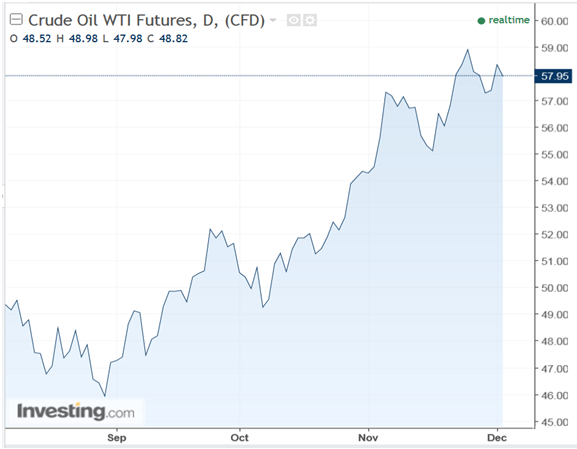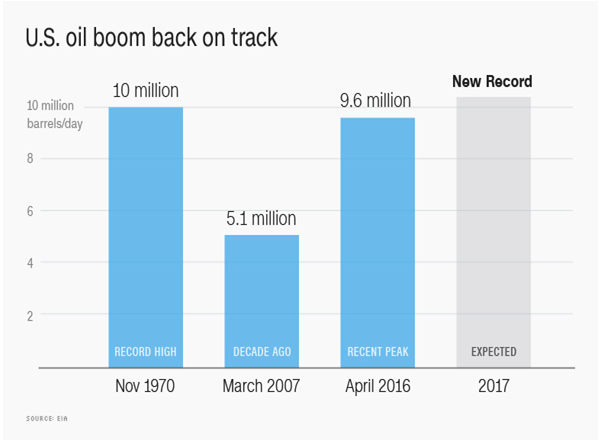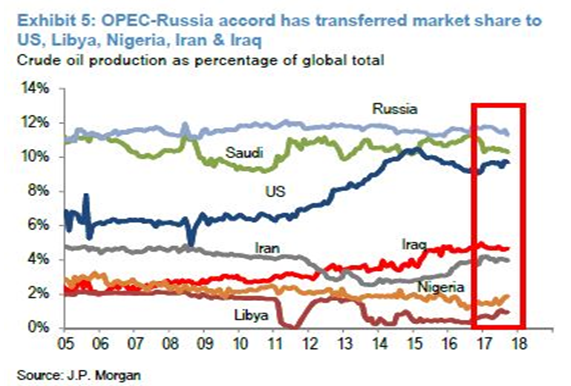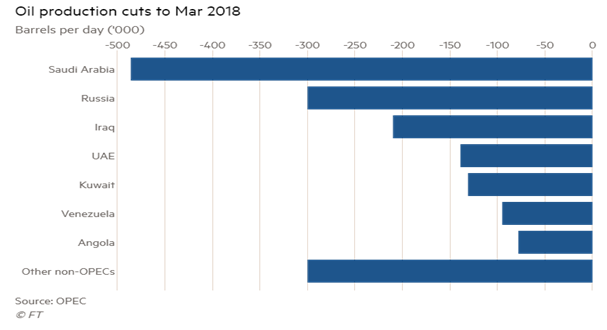by Jesse Cohen
The Organization of Petroleum Exporting Countries (OPEC), along with some non-OPEC producers led by Russia, agreed last week, at OPEC's Vienna meeting to extend current oil output cuts for a further nine months until the end of 2018, as was widely expected.
"It’s been a good long day… in fact, it’s been a great day,” Saudi oil minister Khalid Al-Falih said at a press conference, which took place after the meeting on November 30. “I’m pleased to announce the decision has been unanimous.”
However, the world's largest oil producers also signaled a possible early exit from the deal should the market overheat and prices rise high enough that OPEC's main rivals, U.S. shale producers, start ramping up production. The deal to cut oil output by 1.8 million barrels a day (bpd) was initially adopted during November 2016 by OPEC, Russia and nine other global producers in an effort to rebalance market supply and demand. The agreement was due to end in March 2018, having already been extended once, in May 2017.
Here are the two biggest winners from last week's meeting, and the major producer that winds up at what looks like the losing end of the deal.
Winner #1: U.S. Shale Producers
The biggest winner from the OPEC-led production cuts has been U.S. shale producers, including Exxon Mobil (NYSE:XOM), Marathon Oil (NYSE:MRO) and Chesapeake Energy (NYSE:CHK). Most importantly, they have benefited from higher oil prices, with West Texas Intermediate oil futures returning to around $60 per barrel from lows of $27 hit in January 2016.

The impressive rally in prices over the last year has prompted the U.S. shale industry to shift into high gear. Domestic production has rebounded by almost 15% since the most recent low in mid-2016. According to the U.S. Energy Information Administration (EIA), domestic oil production hit 9.68 million bpd last week, and increasing drilling activity for new production means output is expected to grow further, as producers are attracted by climbing prices.
U.S. energy companies added two oil rigs in the week of December 1, bringing the total count up to 749, the highest since September, General Electric (NYSE:GE)'s Baker Hughes energy services firm said in its closely followed weekly rig count report. Rystad Energy, a U.S.-based oil consulting services firm, recently predicted that U.S. output will hit 9.9 million bpd by the end of 2017, bringing U.S. output close to levels of top producers Russia and Saudi Arabia.

Another front on which U.S. shale producers are beating OPEC as a result of the output-cut agreement: they are grabbing increasing market share, especially in Asia. In a report titled "Christmas comes early," Barclays said on Friday:
"U.S. crude oil exports to China could easily double next year as U.S. production and export capacity expands ... (and) OPEC countries will see their market shares in Asia decline further."

If it continues its rapid pace of production in the months ahead, the U.S. shale industry will remain a thorn in OPEC's side, potentially undermining the group's efforts to rid the market of excess supplies.
Winner #2: Russian Oil Companies
Heading into the November 30 meeting, Russia sent mixed signals about whether it will back the move to extend current production cuts. Complaints from Russia's oil minister, Alexander Novak, as well as from executives at that country's top oil companies have been growing louder in recent months because higher crude prices have helped the U.S. shale industry ramp up production and nibble away at global market share, so the fact that last week's agreement also included a review of the production limits at the next OPEC meeting in June proved to be a big win for them.
A senior Gazprom Neft (OTC:GZPFY) executive said early last month that the company was ‘holding its nose’ to the output-cut deal because it had made the firm lower its production growth targets. Other Russian oil companies voiced the same concerns leading up to the meeting, arguing that their production restrictions were hurting their bottom line.
The extended production cuts would also postpone significant Russian production capacity increases even further, especially for the influential Rosneft (OTC:OJSCY).

Those apprehensions prompted Russia's OPEC delegation to push for a clear message on how to exit the cuts, in order to avoid a scenario in which energy markets flip into a deficit too soon, prices rally too fast and rival U.S. shale firms boost output even further.
The chief executive of Russia's top private producer Lukoil (OTC:LUKOY) said in the aftermath of the OPEC meeting that he would like to see the price of oil stable at current levels, trading in the $60-65 per barrel range.While Novak stated that all Russian oil companies were on board with the latest production limits, Russia’s oil barons could renege on the agreement at the first sign of an overheated market.
In response to those worries, Saudi Arabia's Al-Falih said the group will be “agile” and “on its toes,” ready to respond if market conditions change significantly, a nod to Russian officials who had expressed concern that extending the output cuts might encourage the U.S. shale sector to pump more crude.
At the end of the day, Moscow sees more advantages in lower oil prices, so adding an option to review the deal in June was a big win for Russia's oil companies, who are already having second thoughts about the nine-month extension.
The Loser: Saudi Arabia
Saudi Arabia has been the main driver behind the ongoing push to rebalance the market and support prices, with Riyadh scaling back output levels much more when compared to the rest of the countries participating in the output-cut deal.

Speaking after last week's meeting, Saudi oil minister Khalid Al-Falih boasted that the production-agreement has already reined in excess supplies, but further cuts are needed to bring global crude inventories back to the five-year average.
Falih said it was premature to talk about exiting the cuts, at least for a couple of quarters, as the world was entering a season of low winter demand, downplaying the option that a change in policy could come at OPEC's next meeting in June.
"When we get to an exit, we are going to do it very gradually ... to make sure we don’t shock the market," he said.
Riyadh’s stance represented a shift from its recent role of urging restraint and seeking to convince fellow members that prices rising too fast benefited alternative energy providers. “Saudi Arabia is now the main price hawk,” said a high-level OPEC source.
What has prompted the Saudi's to rethink their OPEC policies is the upcoming Aramco IPO, the kingdom's crown jewel. The IPO, set to happen in the second half of 2018, has been billed as the largest ever public offering, with Saudi officials bragging that Aramco is worth some $2 trillion. As such, there is a desire to push up oil prices to maximize the valuation of Aramco ahead of the listing.
High oil prices are also necessary for the economic reforms 31-year-old Crown Prince Mohammed bin Salman has planned as part of his "Vision 2030" plan.
Once the de facto leader of OPEC, the Saudis have seen some of their influence wane within the group, a cause for concern among officials in Riyadh. Indeed, Russia seems to have replaced Saudi Arabia as the market swinger, along with U.S. shale.One OPEC source that requested anonymity, said that Russian President Vladimir Putin is “calling all the shots” in energy markets.
So far, the interests of the Saudis and Russia seem to be aligned, but that could change sooner than markets expect. If the production deal will be successful in removing 1.8 million bpd of supply from the market until the end of next year, there’s no doubt that global inventories will move back into balance and potentially even overshoot and push things too far.
WTI prices could bounce above $60 and even reach the $70-level, which would spark an even stronger drilling response from U.S. shale, further undermining the Saudi's objective.

